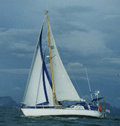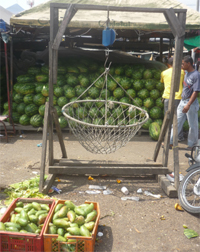Weatherly Sailing Adventures









My sailing guide books told me that very rough seas could be expected along the coast from
Aruba down to Cartagena.
This is due to the build up of waves from the Caribbean trade winds as well as the northeast wind itself,
confronting strong northbond currents head-on.
So I checked weather information on the internet, and having a favorable weather window, made a run for it, to get past the most treacherous part.
I maintained a 20minute watch system for 3 days and nights, resetting my wristwatch alarm to get me up and check for any ships and my navigation along the coast. The wind was usually around 15 knots, though the direction changed often. I had this lucky break in the weather, and I preferred to use it, rather than pulling in to some anchorages I had in mind, for contingency rest stops.
I was also in radio contact with another yacht in the same vicinity, though he soon passed me into the night's horizon.
One hazy morning, three days after leaving Aruba, I motored in under the lee of some deep valleys
and high mountains (there was snow up there apparently) to a small village called Garacia.
There were simple
fishermens huts ashore with thatched roofs, but not much activity. I took a deep sleep to replenish
my energy, waved to some local fishermen who passed close by in the afternoon, and set off again the
following morning.
The wind was very changeable, ranging from 30 knots to less than 10 knots and from varying directions, which made it tiring to keep changing the sails and starting up / stopping the motor. Then, after passing Baranquilla Pt in a lumpy, following sea, the mainsail gybed. I'd neglected to tie down the 'preventer' rope from the end of the boom (which holds the foot of the sail).
The boom flew across
while I was below navigating, and the mainsheet (rope) must have lassoed the steering wheel on its
rapid flight across the cockpit.
Crack!
I looked out and saw the beautiful teak steering wheel at an oblique angle, with 5 of the 6 spokes broken. I took the wheel off while the autopilot still had control of the steering. Straightening up the wheel gently, with a hammer, I found that there was still some mechanical strength left in the spokes, but I would be very careful with navigating in to Cartagena, and prepared to sail off the coast if the weather changed, to avoiding any risk of losing control of the steering. I dug out the emergency tiller arm in case it was needed.
Luckily the wind was kind and very light and the autopilot managed wonderfully. I took the steerage by hand through a narrow gap in an underwater breakwall, and motored in though a large bay, past a huge statue of Mary, to the yacht club in Cartagena.
Cartagena was a great place for me to get some much needed repairs done, and I stayed 10 days
running around and getting the stuff I needed. I bought 4 new
deep cycle Trojan batteries, as my old ones wouldn't accept charge adequately.
Then I located a replacement membrane for the injector pump governor, which I'd hand stitched in
Curacao. It was a slightly different model, but worked just as well after testing.
The broken spinnaker pole was welded and painted up
A computer shop replaced the LED screen on my laptop, which had taken a splashing from a freak
wave. The screen had several worrying blotches on it which were expanding, and were obscuring some vital
information in my electronic chart system.
Also I hired a local boat-boy to help me grind out rust on the decks and cockpit, replace the filler
and painted over with primer and polyurethane.
The town itself has a charming European feel to it. It was built by the Spanish (named after Cartagena
in Spain, which I was fond of, and visited with my dad). It has a fortified wall surrounding the citadel,
with cannon emplacements and stone embattlements. Enclosed within its walls were
fountains, plazas, churches, parks, majestic old Spanish buildings and statues, even an old clocktower
dominating the entrance to the walled city.
There was also a separate fortress up on a hill,
and was an important military stronghold at one time in it's history.
I enjoyed exploring the town. The old city has a civilised atmosphere, and tourists can wander around without the fear of being mugged, which was felt in Margarita in Venezuela. One day I saw some street performers dancing Cumbia, an energetic dance with African origins. There were plenty of other buskers and street artists, which added life and colour to the city.
I found some very good outdoor markets where I could restock all my fresh vegetables, fruit, fish and meat, and I was soon ready to sail again.
I said farewells to my friends on other yachts and motor-sailed off to the Isla Rosarios, about 30 miles down the coast against the current.
I tried to push the engine to test if I could get up sufficient speed for the Panama canal transit. It was a long way around Cape Horn, if I couldn't ! The books say a vessel must maintain 6 knots, and canal authorities say 8 knots (impossible for Weatherly). I was nervous about this transit, because I had an injector fuel line burst at the end of the Suez canal when pushing the motor to it's limits.
The high temperature alarm sounded and I found if I opened the side panels surrounding the motor I could get a few hundred RPM's higher without overheating.
I anchored in a tranquil spot in the Rosario islands. In the morning a friendly lobster fisherman in a log canoe came to visit. Unfortunately I had run out of US dollars and any other cash, so didn't buy the lobster he presented.
When I set off, carefully through the reefs, my temperature alarm went off, at low speed, and
I found an injector line had cracked. I stopped the motor, drifting along, and replaced the injector tube.
Then another one went, and a third one. This didn't seem good.
It takes
about 3 or 4 hours for me to bend a straight injector line around other lines and into perfect spacial and radial
alignment with injector pump and injector.
On close inspection I found that it was the tube tips causing the problem. They have a forged seam line that scores
the locking nut when tightened, then fuel seeps from the nut. After over-tightening the nut (to stop the fuel
seepages) the tubes split near the tips, because metal expands when it gets hot. I filed off the seam lines and
the new tubes held together better, until I replaced them with better designed ones in Panama (with a soft
washer inside the nut). One of the injectors became blocked, possibly from dirt or a metal filing, and luckily I had
a spare which was interchanged, and the motor ran much smoother.
I was underway again, across the gulf to Panama, and rejoiced when the motoring speed reached 6 knots, at a maximum engine revs of 2100RPM, without overheating, for a stint of several hours.
I patched up a split in the fibreglass dinghy while underway and was soon in the next country.







